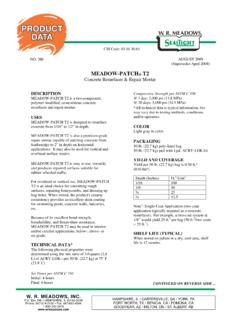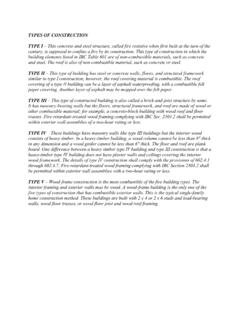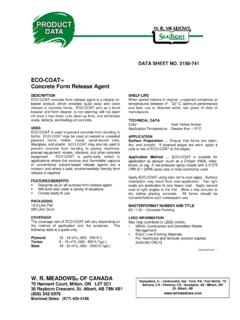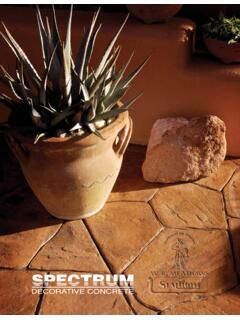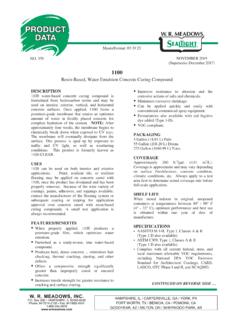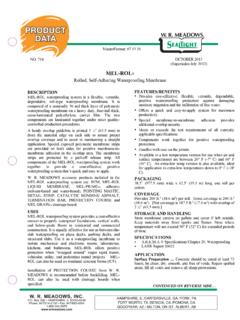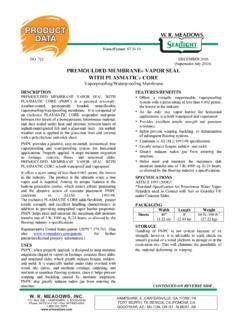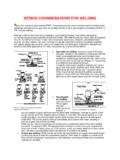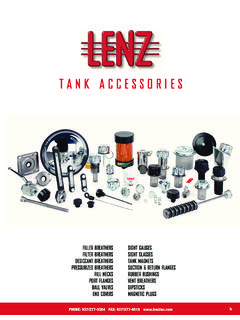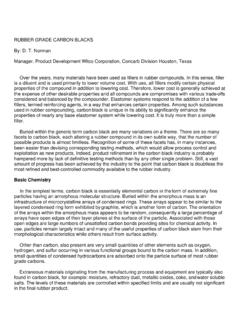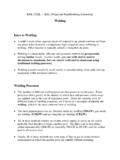Transcription of Fibre Expansion Joint #320-F - W. R. Meadows
1 DESCRIPTION Fibre Expansion Joint is composed of cellular fibers securely bonded together and uniformly saturated with asphalt to assure longevity. Wherever a cost-effective Joint filler is required, Fibre Expansion Joint meets the need. Manufactured and marketed by W. R. Meadows since the early 1930s, Fibre Expansion Joint is backed by over 80 years of proven application experience. Fibre Expansion Joint is versatile, resilient, flexible, and non-extruding. When compressed to half of its original thickness, it will recover to a minimum of 70% of its original thickness. Fibre Expansion Joint will not deform, twist, or break with normal on-the-job handling. Breakage, waste and functional failure resulting from the use of inferior, foreign fiber materials can cost you time and dollars and can result in a substandard finished job, generating costly callbacks and rework expenses.
2 However, the purchase and installation of Fibre Expansion Joint (a small segment of the total project s cost) contributes to both the final cost efficiency and functional success, far greater in proportion than its original cost. Representative United States patents: USPNs 7,815,722; 8,057,638; 8,038,845; and D558,305. (See also for further patent/intellectual property information.) USES Fibre Expansion Joint is ideal for use on highways, streets, airport runways, sidewalks, driveways, flatwork, and scores of commercial and industrial applications subject to pedestrian and vehicular traffic. FEATURES/BENEFITS Provides the ideal product for the majority of all Expansion /contraction Joint requirements. Non-extruding.
3 Versatile .. offers a minimum 70% recovery after compression. This tough, lightweight, easy-to-use, semi-rigid Joint filler is available in strips and shapes fabricated to your requirements. Easy to cut .. dimensionally stable .. not sticky in summer or brittle in winter. Provides neat, finished joints requiring no trimming. Often copied .. but never equaled. Remains the standard of the industry today .. with over 80 years of proven and satisfactory performance. Can be punched for dowel bars and laminated to thicknesses greater than 1 ( mm). Fibre Expansion Joint Multi-Purpose, Expansion -Contraction Joint Filler MasterFormat: 03 15 00 NO. 320-F APRIL 2018 (Supersedes March 2016) CONTINUED ON REVERSE Conforms to or meets: Thickness Slab Widths Standard Lengths Weight per AASHTO M 213 ASTM D1751 Corps of Engineers CRD-C 508 FAA Specification Item HH-F-341 F, Type 1 3/8 , 1/2 3/4 , 1 ( , , , mm) 36 , 48 (.)
4 91, m) 10 ( m) Also available: 5 , 6 , 12 ( , , m) >19 lb. SPECIFICATIONS AND SIZE INFORMATION APPLICATION Fibre Expansion Joint is positioned against the forms, at interrupting objects or columns, and against abutting structures prior to the placement of concrete. Fibre Expansion Joint should be installed 1/2 ( mm) below the concrete surface to accept a Joint sealant which will provide for maximum protection from water infiltration and weathering, in addition to keeping the Joint free from incompressibles. SNAP-CAP from W. R. Meadows is recommended to create the reservoir for the Joint sealant and the use of POURTHANE SL, POURTHANE NS, or DECK-O-SEAL as the sealant to protect the Joint . Before sealing, slide SNAP-CAP over the top of the Expansion Joint .
5 Place the concrete and screed to finish grade, as usual. When concrete is cured, insert a screwdriver through the top of SNAP-CAP, pull free and discard. In applications where one of the above-mentioned Joint sealants is used without SNAP-CAP, W. R. Meadows recommends the use of KOOL-ROD or a bond-breaker tape to isolate Fibre Expansion Joint from the Joint sealant material. SOF-SEAL or any hot-applied sealant, such as HI-SPEC , can be used to protect the Joint . In this case, the use of SNAP-CAP, KOOL-ROD, or a bond-breaker tape is not necessary. Simply apply the sealant directly over Fibre Expansion Joint . LEED INFORMATION May help contribute to LEED credits: MRc9: Construction and Demolition Waste Management For most recent data sheet, further LEED information, and SDS, visit PAGE 2.
6 Fibre Expansion Joint #320-F .. APRIL 2018 W. R. Meadows 2018 04/18-400 TYPICAL APPLICATIONS
